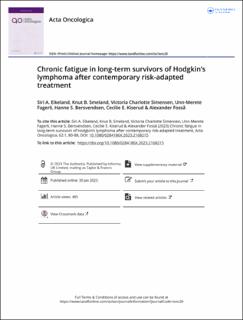| dc.description.abstract | Background
Chronic fatigue (CF), substantial fatigue for ≥ six months, can manifest as a late effect (LE) after cancer treatment, and may affect several aspects of life. In a Norwegian cohort of Hodgkin’s lymphoma survivors (HLS), more than a decade after contemporary risk-adapted treatment regimens with limited use of radiotherapy (RT), we assessed: (1) Prevalence of, (2) factors associated with (3) and implications of CF on socioeconomic status (SES) and work ability (WA).
Material and methods
HLS treated between 1997–2006, aged 8–49 years at diagnosis, were invited to participate in a population-based cross-sectional study on late effects in 2018–2019. In a mailed questionnaire, HLS responded to a fatigue questionnaire (FQ), work ability score (WAS) and short-form health survey (SF-36). Disease- and treatment data were extracted from hospital records. Factors associated with CF were identified by uni- and multivariate analysis. To study the implications of CF on SES and WA, a multinomial regression analysis was performed.
Results
Invitations were extended to 518 HLS and 298 (58%) responded to FQ, of whom 42% had CF with mean (standard deviation [SD]) physical- and mental fatigue scores of 10.2 (4.3) and 5.5 (2.1) respectively. Median age at survey was 45 years, 47% were females. In multivariate analysis female sex (p = 0.03), lower education (p = 0.03), body mass index ≥30 kg/m2 (p = 0.04), and an increasing number of comorbidities (p = 0.01) were associated with CF. No association with disease stage, chemotherapy or RT was found. CF was associated with poorer WAS scores at survey (p < 0.001), unemployment (p = 0.03), and receiving disability pension (p = 0.003).
Conclusion
After risk-adapted treatment, CF is still a frequent LE among long-term HLS, without apparent association with disease or treatment-related parameters. CF is associated with reduced WA and SES. As no apparent risk reduction is seen with contemporary treatment, further studies should emphasize etiological factors of CF and treatment to alleviate this common LE. | en_US |

